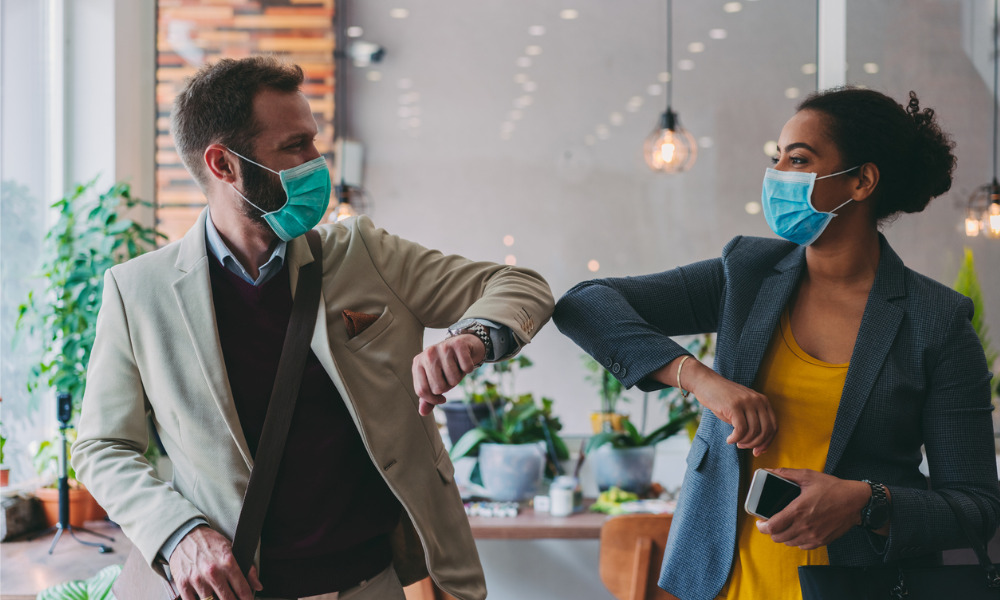‘Continuous education and communication are key, as is implementing risk mitigation measures’

It may be hard to imagine but just a year ago, the coronavirus was merely a recent yet still distant development from China. Fast forward to the present and the world has turned upside down and, even though new vaccines show light at the end of the tunnel, it is difficult to predict just how long that tunnel will be.
Preceded by SARS in the early 2000s and the Middle East coronavirus syndrome in 2012, COVID-19 is the third coronavirus outbreak, but the only one to reach a pandemic scale. Despite its impact and the work of the global scientific community, much is still unknown about the virus, the vaccine, and its full effectiveness beyond clinical trials. We still have a long road ahead.
Continuous education and communication are key, as is implementing risk mitigation measures. From Risk Identification to Mitigation In the past year, governments and employers have implemented several measures to mitigate the risk of propagation of COVID-19: physical distancing and mobility restrictions aim to limit the movement of people to contain or slow down the spread, socio-economic restrictions target activities that involve social gatherings, and communication measures support all risk mitigation steps. In implementing the various restrictions, the best approach has proven to be using a combination of them and leveraging existing and emerging technology to support the rollout of measures. Audit tools allow employers to check compliance with government and company guidance. Access pre-screening technology helps to “stop the virus at the gate” and improves information sharing in multi-employer worksites. It enhances prevention processes and, in turn, risk governance.
Leading technology allows employers to combine, in a single platform, audit protocols and screening procedures to reduce the load of tools to be used and improve efficiency and adoption throughout the enterprise while mitigating risks. Reopening the Workplace after COVID-19 Earlier in January, the WHO reported that, judging by the way the virus is spreading, the second wave will bring much higher levels of propagation than the first one. In Canada, we have seen this prediction hold true based on the number of cases since mid-December. Quebec and Ontario implemented province-wide shutdowns and stay-at-home orders. With a seven-day average hovering over 3,000 new cases in the first two weeks of the year, Ontario’s Chief Medical Officer has recently projected that the province will need to see less than 1,000 new cases per day before lockdown measures are lifted.
Due to the restrictions imposed to contain the COVID-19 outbreak, many workers were temporarily laid off and others moved to remote work. Both returning to work and remaining open during the restrictions carry unique sets of challenges for employers. COVID-19 has introduced a new type of workplace hazard that creates a significant amount of stress for workers due to the risk of infection, especially for those more vulnerable like essential workers, and individuals who are immuno-compromised.
Workers are also under pressure due to community psychological stressors: periodic announcements of new government-imposed restrictions, the constant news of cases often increasing or not being significantly reduced (the curve that does not flatten), increased personal financial pressure, social isolation, fear of job loss and overall economic uncertainty. It is critical for employers to enact risk mitigation measures to contain the spread and avoid an outbreak. This not only protects workers and the community at large; it also helps reduce tension in the workforce and increase productivity.
One of the first steps in managing the risk of COVID-19 in the workplace is to assess the hazard. This includes recognizing that those who enter the site have a potential of introducing the risk. Pre-screening addresses this and it should not only extend to employees, but also service providers, and visitors.
Employers must adjust personal sick leaves and policies, improve communication on the importance of observing the rules and what to do if symptoms present themselves. Signage should be in place not only when there is a pre-screening procedure in place to remind employees to adhere to it, but also when there is not. This way, employees will know not to enter the worksite if they experience any symptoms or conditions normally identified by the screening, e.g., having travelled or been in contact with persons who have travelled or been exposed.
Effective Sept. 25, 2020 and under O. Reg 364/20 of the Ontario Reopening Act, all Ontario businesses must screen workers and essential visitors who enter their premises. Workers not only include company employees but also students, temporary agents, contractors, volunteers, and any visitors to the workplace. There are two types of screening. Active screening calls for employers to not only collect information about their workers, but also to review it and decide as to whether the individual may enter the workplace. Passive screening, on the other hand, allows employees to self-assess their own level of risk and if they may enter the workplace. In Ontario, active screening is now mandated. It can be done in person, over the phone, via email or using an app prior to entry. It should always be done before the worker starts the day and it can be repeated during the shift.
Pre-screening is also required in other provinces. New Brunswick requires that employers have a plan for pre-screening. Newfoundland & Labrador has asked employers to consider pre-screening. Even if not mandated, it is a best practice. Consequences of Non-compliance Under the Occupational Health and Safety Act, employers have a duty to provide a safe work environment for workers, which includes employees, contractors, and visitors. Failure to do so will lead to liability under OHS laws and expose the employer to fines, penalties, as well as civil and criminal liability.
In Alberta, the provincial Workers Compensation Board has started investigating cases of COVID-19 related deaths. In one case, the RCMP has opened a criminal investigation and the company is facing a class-action lawsuit on behalf of individuals exposed because of operating without adequate safeguards despite public health warnings. The complaint is filed under the Westray Law which, as part of the criminal code, assigns responsibility to individuals to take “reasonable steps to prevent bodily harm” to workers.
As for the rest of Canada, so far there have been over 26,000 workers compensation claims filed for individuals who contracted COVID-19 while at work. Quebec, Ontario, and Alberta account for 51 per cent, 30 per cent and 11 per cent, respectively, of all claims filed. However, this is only the number that has been reported - the true figures are much higher. In Ontario, unions have filed complaints against several employers with Toronto and Peel Region police alleging criminal negligence and failure to provide personal protective equipment.
At the start of the year, the City of Toronto announced stricter guidelines for employers to report COVID-19 cases and committed to publicly naming workplaces where there has been an outbreak. The reputational damage to these businesses is bound to be severe and its impact will be manyfold, from a decline in employee morale and productivity to lower financial results through a decline in sales. Over the course of 2020, COVID-19 impacted the way we live in ways that we could not foresee just a year ago. 2021 looks promising with the rollout of new vaccination campaigns. The full impact, however, is not over and both businesses and local communities will be affected for years to come.
As employers, it is part of our social contract to help restrict the spread of the virus through risk mitigation measures that protect our employees, our supply chain, and the communities we serve. We all have a role to play. After all, it is no wonder that one of the most repeated phrases of the past twelve months has been: We are all in this together!






